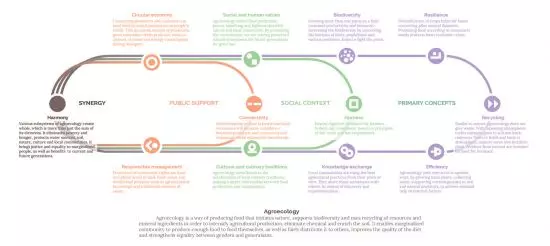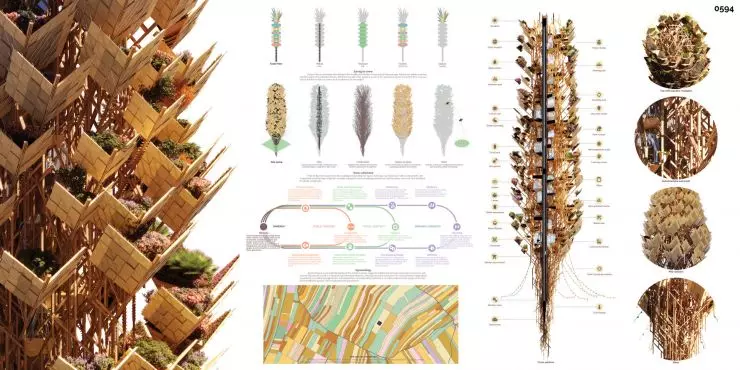In the annual international Skyscraper Design Competition, organized by eVolo magazine since 2006, the task facing participants is to create an innovative high-rise building in which designers take into account such issues as technological progress, scarcity of natural resources, environmental pollution and urban sprawl without a plan, among others. In this year's edition of the competition, the third prize went to the duo of architects - Michal Spólnik and Marcin Kitala - bringing new hope and possible solutions to the problem of world hunger in the New Spring project. Congratulations!
New Spring, or New Spring, is an agro-ecological skyscraper, which the designers envisioned to help confront the paradox of our times - the overproduction and waste of food while food is in short supply, to make us care more about our planet and help us rethink the way we use the earth today.



diagram dedicated to agroecology
© Michal Spólnik, Marcin Kitala
Awarded by an international jury (consisting of: Volkan Alkanoglu, VA | DESIGN; Gianni Botsford, Gianni Botsford Architects; Steven Chilton, Steven Chilton Architects; Tsvetelina Georgieva, DesignMorphine; Nuru Karim, Nudes; Arthur Mamou-Mani, Mamou-Mani Architects and Moon Hoon, Moon Hoon Architects), the design of the unusual skyscraper combines nature, science and social aspects.
The vertical, irregular garden consists of multiple modules, each with different soil, flora, microclimate and microorganisms living in it. A properly prepared module - the nucleus of a future garden or field of crops - can easily be sent to its destination for further development there. This is a response to the radical and far-from-natural use of farmland and the lack of crop diversity, as global food production today is based mainly on a small number of plant and livestock species - the experimental proto-gardens are therefore often to combine plants that are not normally found side by side. As the authors of the project emphasize, this is especially important in the fight against climate change, when some damage cannot be reversed and new solutions are needed.



competition board
© Michal Spólnik, Marcin Kitala
Modules of wooden construction, as the authors of the project emphasize, can be freely added, removed or replaced. They are attached to a core filled with various functions - a space housing laboratories and seed banks, among others. The whole design is reminiscent of the shape of a traditional Easter palm, which the architects intend to symbolize cyclical rebirth and rejuvenation.
With a positive outlook on the future, New Spring will stimulate biodiversity and the intermingling of ecosystems and cultures. The countryside will blossom with a fever of colors, regaining its vitality. But perhaps most importantly, it will promote a culture of sharing and caring for Nature. Our Home," the authors of the award-winning project conclude.



visualization of individual construction elements
© Michal Spólnik, Marcin Kitala
The competition winners, Marcin Kitala and Michal Spólnik, talk about the inspiration and potential of the project
Ola Kloc: In the New Spring project you pose the question of how the world could feed itself. How do you think it would be possible?
Marcin Kitala, Michal Spólnik: Currently, the world is dominated by industrial agriculture, which in many places has displaced smaller, local farmers. Crops grown on a large scale, such as bananas, corn or rice, for example, are genetically uniform, and thus very vulnerable to threats like drought or pest attack, and dependent on certain types of fertilizers. A return to growing local varieties, adapted to local conditions, will reduce the risk of crop failure.



visualization of modules
© Michal Spólnik, Marcin Kitala
It is also worth paying attention to food tech solutions like meat grown from stem cells, all kinds of meal replacements, high-energy rations, insect cultivation or new ways of food storage. Often, after some time, innovative solutions reach those most in need as something commonplace.
Ola: Although your project is modular and, as you emphasize, could "flourish" in many places around the world, you focus on the specifics of Polish villages, and the inspiration for its form was the traditional Easter palm. Tell us, please, more about the design process and the Polish aspects included in it.
Marcin, Michal: The Easter palm, in addition to its religious symbolism, is also a symbol of spring, and in such a colorful form as we know it, it is mainly found in Poland. Often made of the first green or blooming twigs, it was the perfect inspiration for the project, whose final task is to help revitalize degraded areas, thus evoking the eponymous new spring there.
The 


The shape of the skyscraper is inspired by the form of the traditional decorative Easter stain
© Michal Spólnik, Marcin Kitala
Placing the skyscraper in the Polish countryside, to which, after all, we all constantly escape to relax, communing with nature, already seemed a logical continuation.
Ola: New Spring is an experimental project in many ways, how do you think it could revolutionize thinking about ecology and crops?
Marcin, Michal: We certainly can't completely move away from globalization and lock ourselves into our agricultural communities. Instead, we can think about how to secure our local crops, for example by mixing native crops with those (also local) from similar latitudes, so that we get more biodiversity and benefit from globalization.
Another trend to watch is the development of urban agriculture, for which vacant lots, rooftops or basements can be used. This carries with it a number of positive aspects, such as shortened transportation, new jobs and improved urban climate.
Ola: Thank you for the interview.





























